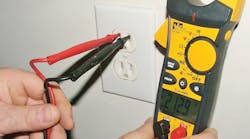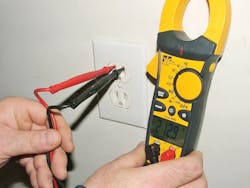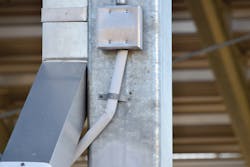How well do you know the Code? Think you can spot violations the original installer either ignored or couldn’t identify? Here’s your chance to moonlight as an electrical inspector and second-guess someone else’s work from the safety of your living room or office. Can you identify the specific Code violation(s) in this photo? Note: Submitted comments must include specific references from the 2017 NEC.
Hint: The meter doesn’t lie.
August Winners
Our two winners this month — Dan Haruch, an electrical instructor for Brightwood Career Institute in Philadelphia, and Brad Bennati, owner of Bennati Electrical Services LLC in Altoona, Pa. — knew there were some concerns with the bending methods used on this PVC conduit.
Section 352.24 requires field-made bends in PVC conduit to be made with identified bending equipment, such as heating blankets, heater boxes, and other equipment specifically made for the purpose. This PVC looks as though the installer tried to bend the conduit by simply folding it around his knee. The conduit is now kinked and damaged, and its internal diameter has most likely been reduced.
A closer look reveals that the conduit has no connector, and it is not even secured to the box. It is partially pushed into the threaded box hole but not secured to the box, as required by Sec. 314.17(B).
It may be tough to tell from this angle, but there was no gasket between the weatherproof box and the cover. For this outdoor wet location,
Sec. 314.15 requires boxes to be placed or equipped to prevent moisture from entering them. With the gasket missing, moisture may be able to enter the box and damage any splices or connections inside.






